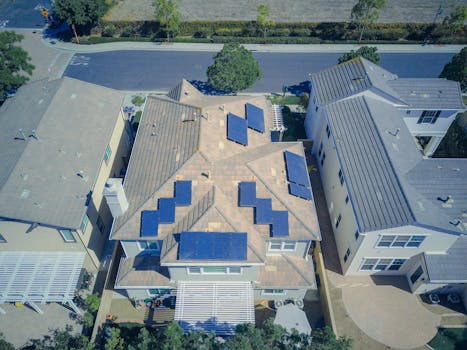“Weathering the Storm: How Climate Conditions Shape Solar Battery Efficiency.”
The performance of solar batteries is significantly influenced by weather conditions, which can affect both the efficiency of solar panels and the overall energy storage capabilities. Factors such as temperature, humidity, and sunlight intensity play crucial roles in determining how effectively solar batteries charge and discharge. For instance, extreme temperatures can lead to reduced battery efficiency, while overcast or rainy days can limit solar energy generation. Understanding these weather-related impacts is essential for optimizing solar energy systems and ensuring reliable energy storage, particularly in regions with variable climates. This introduction explores the intricate relationship between weather patterns and solar battery performance, highlighting the importance of considering environmental factors in solar energy planning and implementation.
Temperature Effects on Solar Battery Efficiency
The performance of solar batteries is significantly influenced by temperature, which plays a crucial role in determining their efficiency and longevity. As solar energy systems become increasingly popular, understanding how temperature affects these batteries is essential for optimizing their performance and ensuring reliable energy storage. When temperatures rise, the chemical reactions within the battery can accelerate, leading to increased efficiency in energy conversion. However, this is not a straightforward relationship, as excessively high temperatures can also result in detrimental effects. For instance, lithium-ion batteries, commonly used in solar energy systems, tend to perform optimally within a specific temperature range, typically between 20°C and 25°C. When temperatures exceed this range, the risk of thermal runaway increases, which can lead to battery degradation, reduced capacity, and even safety hazards.
Conversely, low temperatures can also pose challenges for solar battery performance. At lower temperatures, the chemical reactions that facilitate energy storage and release slow down, resulting in decreased efficiency. This phenomenon is particularly evident in colder climates, where solar batteries may struggle to deliver the expected power output. In such conditions, users may notice a significant drop in the battery’s ability to hold a charge, which can be frustrating, especially during peak energy demand periods. Therefore, it is essential for users to be aware of the temperature conditions in their specific locations and how these may impact their solar battery systems.
Moreover, the impact of temperature on solar battery performance extends beyond just efficiency; it also affects the overall lifespan of the battery. High temperatures can accelerate the aging process of battery components, leading to a shorter operational life. This is particularly concerning for users who have invested in solar energy systems, as the cost of replacing batteries can be substantial. On the other hand, consistently low temperatures can lead to increased internal resistance, which can also contribute to premature battery failure. Thus, maintaining an optimal temperature range is vital for maximizing both performance and longevity.
To mitigate the adverse effects of temperature fluctuations, many manufacturers are now designing solar batteries with advanced thermal management systems. These systems help regulate the temperature within the battery, ensuring that it operates within the ideal range regardless of external conditions. Additionally, users can take proactive measures to protect their solar batteries from extreme temperatures. For instance, installing batteries in shaded or insulated areas can help maintain a more stable temperature, thereby enhancing performance and extending lifespan.
Furthermore, it is important to consider the seasonal variations in temperature when planning solar energy systems. In regions with significant temperature swings, users may need to adjust their energy storage strategies accordingly. For example, during the summer months, when temperatures are high, users might consider implementing cooling solutions or selecting batteries specifically designed to withstand elevated temperatures. Conversely, in winter, users may need to account for reduced efficiency and plan for additional energy storage capacity to meet their needs.
In conclusion, temperature plays a pivotal role in the efficiency and longevity of solar batteries. Understanding the effects of both high and low temperatures is essential for optimizing performance and ensuring reliable energy storage. By implementing effective thermal management strategies and being mindful of seasonal variations, users can enhance the performance of their solar battery systems, ultimately leading to a more sustainable and efficient energy solution.
The Role of Humidity in Solar Battery Performance

Humidity plays a significant role in the performance of solar batteries, influencing their efficiency and longevity in ways that are often overlooked. As solar energy systems become increasingly popular, understanding the impact of environmental factors, particularly humidity, is essential for optimizing their performance. High humidity levels can lead to various challenges for solar batteries, affecting both their operational efficiency and overall lifespan.
To begin with, it is important to recognize that solar batteries are designed to store energy generated by solar panels for later use. However, the chemical processes that occur within these batteries can be sensitive to changes in humidity. When humidity levels are high, the moisture in the air can infiltrate the battery casing, potentially leading to corrosion of internal components. This corrosion can compromise the battery’s ability to hold a charge, ultimately reducing its efficiency. In contrast, low humidity levels can also pose challenges, as excessively dry conditions may lead to increased evaporation of the electrolyte solution within the battery, which can further diminish performance.
Moreover, the interaction between humidity and temperature cannot be ignored. High humidity often coincides with elevated temperatures, creating a challenging environment for solar batteries. Elevated temperatures can accelerate chemical reactions within the battery, which, while initially beneficial for energy production, can lead to faster degradation of the battery materials over time. Consequently, the combination of high humidity and temperature can create a perfect storm that negatively impacts battery performance, leading to a shorter lifespan and reduced energy output.
In addition to these physical effects, humidity can also influence the overall efficiency of solar energy systems. When solar panels are exposed to high humidity, they may experience a reduction in their ability to convert sunlight into electricity. This reduction occurs because moisture can create a thin film on the surface of the panels, obstructing sunlight and reducing the amount of energy that can be harvested. As a result, the energy available for storage in the batteries diminishes, further compounding the issues associated with high humidity.
Furthermore, the impact of humidity on solar battery performance is not uniform across all battery types. For instance, lithium-ion batteries, which are commonly used in solar energy systems, may exhibit different responses to humidity compared to lead-acid batteries. Lithium-ion batteries tend to be more resilient to humidity fluctuations, but they still require careful management to ensure optimal performance. On the other hand, lead-acid batteries are more susceptible to the adverse effects of humidity, making it crucial for users to monitor environmental conditions closely.
To mitigate the negative effects of humidity on solar battery performance, several strategies can be employed. For instance, installing solar batteries in climate-controlled environments can help maintain optimal humidity levels, thereby prolonging their lifespan and enhancing efficiency. Additionally, regular maintenance and monitoring of battery health can identify potential issues before they escalate, allowing for timely interventions.
In conclusion, humidity is a critical factor that influences solar battery performance, affecting both efficiency and longevity. By understanding the complex interactions between humidity, temperature, and battery chemistry, users can take proactive measures to optimize their solar energy systems. As the demand for renewable energy continues to grow, recognizing and addressing the impact of environmental factors like humidity will be essential for maximizing the benefits of solar technology.
How Cloud Cover Influences Solar Energy Storage
The performance of solar batteries is intricately linked to the weather, particularly the presence of cloud cover, which can significantly influence the efficiency of solar energy systems. When clouds obscure the sun, they reduce the amount of direct sunlight that reaches solar panels, thereby affecting the energy they can generate. This diminished solar input not only impacts the immediate energy production but also has implications for how effectively solar batteries can store energy for later use.
To understand this relationship, it is essential to recognize that solar panels rely on sunlight to produce electricity through the photovoltaic effect. Under clear skies, solar panels can operate at or near their maximum efficiency, converting sunlight into usable energy. However, when cloud cover rolls in, the intensity of sunlight diminishes, leading to a reduction in the energy output of the solar panels. This decrease can be substantial, with some studies indicating that cloudy conditions can reduce solar energy production by as much as 50% or more, depending on the thickness and type of cloud cover.
As a result, the energy that solar batteries can store during these periods is also affected. When solar panels generate less electricity, the batteries receive a smaller charge, which can lead to insufficient energy storage for later use. This situation is particularly critical for users who rely heavily on solar energy for their power needs, as they may find themselves facing energy shortages during prolonged cloudy periods. Consequently, the effectiveness of solar batteries is not solely determined by their capacity or technology but is also influenced by the environmental conditions under which they operate.
Moreover, the impact of cloud cover on solar energy storage is not uniform; it varies with the type of cloud cover present. For instance, thin, high-altitude clouds may allow some sunlight to penetrate, resulting in a less dramatic reduction in energy production compared to thick, low-lying clouds that block sunlight more effectively. Additionally, the duration and frequency of cloud cover play a crucial role in determining how much energy can be stored. A brief period of cloudiness may not significantly affect overall energy storage, but extended cloudy days can lead to a cumulative deficit in energy generation.
In light of these factors, it becomes evident that solar energy systems must be designed with weather variability in mind. Advanced forecasting technologies can help predict cloud cover and its potential impact on energy production, allowing users to adjust their energy consumption accordingly. Furthermore, integrating energy storage solutions with smart management systems can optimize the use of available solar energy, ensuring that batteries are charged efficiently even during less-than-ideal weather conditions.
In conclusion, cloud cover has a profound impact on solar battery performance, influencing both energy generation and storage capabilities. As solar technology continues to evolve, understanding these weather-related dynamics will be crucial for maximizing the efficiency and reliability of solar energy systems. By acknowledging the interplay between cloud cover and solar energy storage, users can better prepare for fluctuations in energy availability, ultimately leading to a more resilient and sustainable energy future.
Seasonal Variations and Their Impact on Solar Battery Lifespan
The performance and lifespan of solar batteries are significantly influenced by seasonal variations, which can affect both the efficiency of solar panels and the overall energy storage capabilities. Understanding these seasonal impacts is crucial for optimizing solar energy systems and ensuring that they operate at peak performance throughout the year.
During the summer months, solar panels typically receive maximum sunlight exposure, leading to increased energy production. This abundance of sunlight allows solar batteries to charge more quickly and efficiently. However, the high temperatures associated with summer can also pose challenges. Elevated temperatures can accelerate the chemical reactions within batteries, potentially leading to a decrease in lifespan if the batteries are not designed to handle such conditions. Therefore, while summer can enhance energy generation, it is essential to monitor battery temperatures and implement cooling solutions to mitigate any adverse effects.
As the seasons transition into fall, the amount of sunlight begins to diminish, which can impact the charging cycles of solar batteries. Shorter days and increased cloud cover reduce the energy harvested from solar panels, leading to less frequent charging of the batteries. This reduction in charging can result in deeper discharge cycles, which, if not managed properly, may shorten the overall lifespan of the batteries. To counteract this, users should consider adjusting their energy consumption patterns during the fall months, ensuring that they utilize stored energy efficiently and avoid excessive discharges.
Winter presents a unique set of challenges for solar battery performance. The combination of shorter daylight hours, lower sun angles, and often inclement weather can significantly reduce solar energy production. In regions where snow accumulation occurs, solar panels may become covered, further limiting their ability to generate electricity. Consequently, solar batteries may not receive adequate charging during this season, leading to potential over-discharge situations. To address these issues, it is advisable for users to implement snow removal strategies and consider the installation of solar panels at optimal angles to maximize sunlight exposure during winter months.
As spring arrives, solar energy production typically begins to increase again, providing an opportunity for solar batteries to recharge after the winter months. However, the transition into spring can also bring unpredictable weather patterns, including rain and storms, which may temporarily hinder solar energy generation. It is essential for users to remain vigilant during this time, ensuring that their energy storage systems are adequately charged before any potential weather disruptions occur.
In conclusion, seasonal variations play a critical role in determining the performance and lifespan of solar batteries. Each season presents its own set of challenges and opportunities, requiring users to adapt their energy management strategies accordingly. By understanding the impacts of weather on solar battery performance, individuals can make informed decisions that enhance the efficiency and longevity of their solar energy systems. Ultimately, proactive management and awareness of seasonal changes can lead to a more reliable and sustainable energy solution, maximizing the benefits of solar technology throughout the year.
Q&A
1. **Question:** How does temperature affect solar battery performance?
**Answer:** Higher temperatures can reduce the efficiency and lifespan of solar batteries, while extremely low temperatures can decrease their capacity and performance.
2. **Question:** What impact does humidity have on solar battery systems?
**Answer:** High humidity can lead to corrosion and damage to battery components, potentially reducing performance and lifespan.
3. **Question:** How do cloudy days influence solar battery charging?
**Answer:** Cloudy days can reduce the amount of sunlight reaching solar panels, leading to lower energy production and slower charging of solar batteries.
4. **Question:** What is the effect of snow on solar battery performance?
**Answer:** Snow can block sunlight from reaching solar panels, temporarily reducing energy generation; however, once the snow melts or is cleared, solar production can resume normally.
Conclusion
Weather significantly affects solar battery performance, as factors such as temperature, sunlight intensity, and humidity influence both solar panel efficiency and battery charging capabilities. High temperatures can lead to reduced efficiency in solar panels, while low temperatures can affect battery capacity and discharge rates. Additionally, cloudy or rainy conditions can decrease solar energy generation, resulting in lower battery charge levels. Overall, understanding these weather-related impacts is crucial for optimizing solar energy systems and ensuring reliable performance throughout varying climatic conditions.




